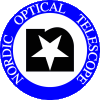Turpol Neutral Density Filters
| Position |
Transmission |
Magnitude shifts |
Useful for
Target brightness |
| 0 |
20 % |
+ 1.8 mag |
V ~ 9 mag |
| 1 |
50 % |
+ 0.75 mag |
V ~ 10 mag |
| 2 |
30 % |
+1.3 mag |
V ~ 9.5 mag |
| 3 |
10 % |
+ 2.5 mag |
V ~ 9 mag |
| 4 |
3 % |
+ 3.8 mag |
V ~ 7.5 mag |
| 5 |
1 % |
+ 5 mag |
V ~ 6 mag |
| 6 |
65 % |
+ 0.5 mag |
V ~ 10.5 mag |
| 7 |
open |
|
V > 11 mag |
- Neutral Density (ND) filters must be used for bright objects.
The requirement is to stay below a count rate of about 100 000. At a count
rate of ~ 150 000, a mirror goes in and redirects the light in order to
automatically spare the photomultiplier tubes. The brightest magnitude
allowed is thus effectively V = 9 (with the attenuation of the ND filter
included). If you are uncertain about target brightness, start with the
densest filter (#5), check the count rates, and change to a less dense one,
if possible. An easy way to check the count rates without starting an
integration is to go to Options, click on Mirror: Meas and
then on TV.
- NB! Note that for very accurate photometry you should have count rates
below about 50 000 to 70 000 for the best stability of the R and I
photomultipliers.
- NEW FILTERS! We have two new ND filters, namely number 6 (65%) and 0 (20%). They have been kindly provided by Svetlana Berdyugina. Thanks!
How neutral are the ND filters?
Transparency coefficients in percents. To be continued.
| ND Filter |
U |
B |
V |
R |
I |
| 50% |
56.9 |
54.2 |
52.9 |
52.0 |
52.1 |
| 30% |
39.7 |
36.1 |
34.4 |
33.3 |
33.2 |
| 10% |
11.0 |
10.8 |
10.9 |
11.4 |
12.0 |
| 3% |
2.9 |
2.8 |
2.9 |
3.3 |
3.6 |
|

